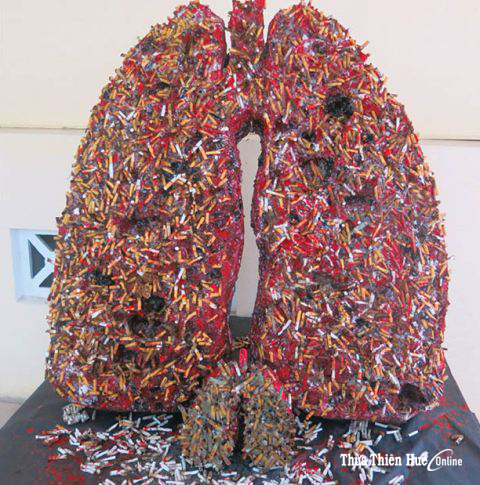
Tran Thi Trinh’s “Aquatic Hourglass”
With no brushes, no paint, and no colorful palettes used, the 24 works (exhibited at the Faculty of Art Education from November 20) in the exhibition "For a green environment" still attracts the viewer by its novelty and uniqueness. The exhibition is strange in that all the works use waste materials. Made only from iron scraps, steel scraps, and synthetic plastic scraps, the works transmit a vivid message about how life is ruined. More importantly, young people want to inspire creativity and spread the beautiful lifestyle, consciously reusing waste and protecting the environment.
Nguyen Thanh Tung, Dean of the Faculty of Art Education, introduced: "The materials used were picked up by students from the streets and nearby areas. Taking advantage of cigarette butts, plastic cups, old barbed wire, broken mirrors, and nylon which are often regarded as useless, under the guidance of teachers, the students have arranged and shaped them into ingenious creations. Large 2D and 3D artworks reflect many different themes on ecological environment."

Nguyen Thi Nga’s “Fragile”
With creativity and clever hands, scrap and waste materials have become unique and impressive. Many large installation works, up to ten meters in length, were elaborately designed. Le Thi Duy Linh - 4th year student of the Faculty of Art Education, said: "People’s needs are turning the earth into a giant dump of garbage. How should they be handled when the daily, hourly amount of garbage is increasing rapidly and the pollution rate is getting worse? Waste is polluting the earth as it destroys the natural habitat of humans as well as animals. We collect scraps and then recycle them into works of art as a way to clean up the environment. With this exhibition, we want to remind people to be more responsible for preserving and protecting the environment before it's too late."
"Destruction" by Le Thi Duy Linh is the image of the lungs which were made from wax and thousands of cigarette butts that were picked up by Linh at cafes. The image of destroyed lungs caused by smoking portrayed in Linh’s work will startle people who smoke. Vo Thi My Linh 's work "Extinction" draws ideas from wild animals being hunted. The simulations imaging monkeys, pangolins, turtles soaked in alcohol for human consumption condemn the act of destroying wild animals and putting them at risk of extinction.
With "Aquatic Hourglass", Tran Thi Trinh used a thousand plastic cups to create an hourglass representing the polluted water environment. At the top, the environment is increasingly being contaminated with waste, and at the bottom of the hourglass, the habitat of aquatic life is being reduced. Waste polluting the aquatic environment and aquatic animals dying are the messages Trinh sent through this work. In "Fragile", Nguyen Thi Nga reminds viewers of fragility by using broken mirrors, eggshells for installations. Eventually with no materials left, birds have to make a nest from barbed wire, which is a warning if we do not know how to preserve the environment. Images of monkeys missing the jungle, jellyfish floating in the contaminated ocean, fish swimming in the dirty water serve as a reminder that everyone must work together for the environment.

Le Thi Duy Linh’s “Destruction”
Composition is a type of visual arts that has just been taught at the Faculty of Art Education. Nguyen Dinh Tung said: "This is a key lesson that helps improve the teaching capacity and responds to the environmental education project of the Ministry of Education and Training. As they will become future teachers, the students will be the ones sending the message of environmental protection for future generations. So, this lesson is very appropriate in promoting the capacity of students. Through their works, we are very pleased that students have understood the problems of contemporary life."
Story and photos: TRANG HIỀN
